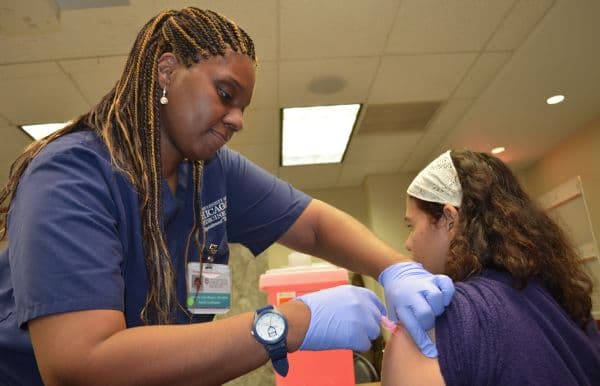Universal flu vaccines could offer key benefits over seasonal shots

Universal vaccines that protect against multiple strains of influenza (flu) virus at once could offer substantial advantages over conventional seasonal flu vaccines, when deployed on a large scale in the human population, according to research published in PLOS Computational Biology. The new study from the University Chicago, Princeton University and Imperial College London demonstrates potential effects of new vaccines that target multiple flu strains using mathematical modeling.
Current flu vaccines provide good protection, but only if they are well matched against a specific flu strain. Flu-causing viruses are continually evolving and cause annual epidemics. Scientists must update vaccines regularly to provide protection against whichever seasonal strains pose the greatest health risk. To keep from updating the vaccines every year, researchers are now working to develop universal vaccines that could protect against multiple flu strains instead.
According to the Centers for Disease Control, it is not possible to predict with certainty if the vaccine will be a good match for circulating viruses. The vaccine is made to protect against the flu viruses that research and surveillance indicate will be most common. However, experts pick which viruses to include in the vaccine many months in advance in order for vaccine to be produced on time.
In addition, every few decades a new virus emerges in the human population that causes a global pandemic, and the current flu vaccines cannot be used to protect the population against the next pandemic virus.
"There are certain proteins that are shared across a wide range of flu viruses. Only now with recent advances in biotechnology has it been possible to develop vaccines targeting these 'conserved antigens'," said UChicago graduate student Rahul Subramanian, the lead author of the study.
These universal flu vaccines currently being developed in the laboratory could protect against a broad range of seasonal flu viruses without having to be updated, as well as protecting against pandemic flu strains.
Research on universal flu vaccines has mostly focused on their potential effects in individual patients. To better understand their effects at the population level, Subramanian and colleagues mathematically modeled the interactions between vaccination, flu transmission and flu virus evolution.
"We asked the question: How would a universal flu vaccination program compare against a similar program using only current flu vaccines?" said Subramanian. "We wanted to know how would each compare in their ability to control seasonal flu, reduce the pace of flu evolution, and protect against the next influenza pandemic." The model revealed that deployment of universal vaccines across large populations could reduce flu transmission more effectively than conventional flu vaccines. It could also slow the evolution of new strains of flu virus and bolster the immunity of a population, allowing protection against the emergence of dangerous pandemic strains.
"New flu vaccines could, for the first time, maintain their effectiveness in the face of viral evolution," said Subramanian. "In doing so, they could transform the way we manage flu in future."
However, when conventional vaccines are well matched against circulating flu strains they are highly effective at blocking infection and are likely to continue to play an important role. Strategic decisions about their deployment, alongside novel vaccines, could be guided by anticipated population impact, as well as their effectiveness in individuals.
"Our work suggests an optimal approach may be to strategically use universal vaccines alongside conventional vaccines to protect the health of at-risk groups while promoting immune defense of the whole population," said Subramanian.
Additional authors include Andrea Graham and Bryan Grenfell from Princeton University, and Nimalan Arinaminpathy from Imperial College London. This work was supported by: Health Grand Challenges Program, Center for Health and Wellbeing, Princeton University; Bob and Cathy Solomon Undergraduate Research Fund, Princeton Environmental Institute, Princeton University, and MRC Centre for Outbreak Analysis and Modeling.
